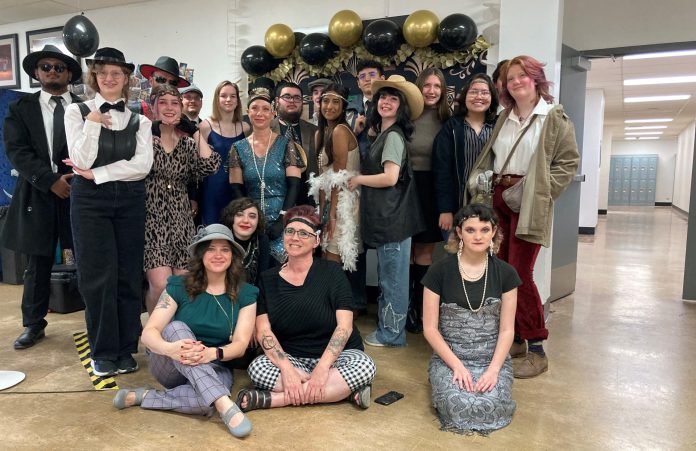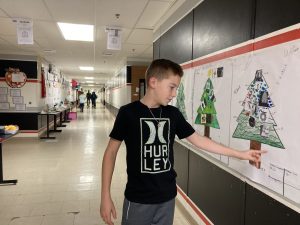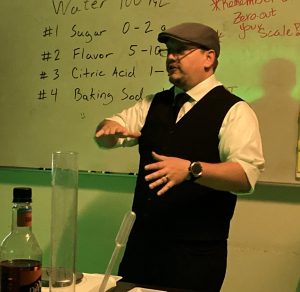
Instead of ending the fall semester with final exams, STEM Academy students dove into projects — Museum Day for the middle school and the Gatsby Speakeasy and Gala for the high school.
Museum Day was a culmination of what the students have learned in all the subject areas, Middle/High School Principal Cody Griffin said. The project culminating events involved more than 400 students in the middle and high school.
“Every single subject — English, math, science, social studies — they all have different projects throughout the semester. In this instance, the kids are displaying some of those projects for their parents to come through and see what they worked on,” Griffin said.
Sixth-grader Curtis Shipman gave a tour of the middle school projects that lined one of the hallways. Their projects covered budgets, Christmas ornaments, a Christmas tree, mapping, creating their own countries and weapons.
“The sixth graders are covering world cultures, so they look at the different areas of the world and they look at things like their government structures, their culture, their religion,” Griffin said.
They devised their own country, flag, currency, religion and how many people per square mile. They also created alliances and had battles. Shipman’s country didn’t have a specific religion.
The main food of the country Shipman and his classmates created, Wano, was peanut butter and jelly. It’s depicted in the flag as a purple strip.

Bess Battreall teaches sixth and seventh grade English language arts. Her sixth graders read the book Holes and the seventh graders read the book Refugee.
Battreall said the sixth graders had to put different elements into a poster. For Refugee, her seventh graders had to choose one of the three characters to focus on.
“They had to complete a character analysis which included quite a bit of information. They had to write a letter as if 10 years had passed in the novel from a character’s point of view, a plot diagram, the same as they did in Holes. They also had to research, because this is a historical fiction book, so they had to research either the Holocaust, the Cuban Revolution, depending on their character … also how to complete a map … and their route that they would have taken in order to try to find a place for refuge,” Battreall said.
The character Isabel from Refugee was escaping from Cuba during the Cuban Revolution. She first went to the Bahamas, but they wouldn’t let them in so they ended up in Miami where they didn’t find it easy either.
There were also characters from the Holocaust and the war in Syria.
“I have sixth and seventh grade. And so each group finished a different novel,” Battreall said.
She noted that this could have been a final exam using paper and pencil and letting her know what elements of the plot they understood. But the projects allow them to collaborate.
“One kid might be stronger in something than another kid, but they’re helping each other out. I’m always very clear that I better see everybody’s participation and everybody’s writing. They’re learning from each other,” Battreall said.
With a final exam, the students get it right or wrong and they get feedback from the teacher. But this way, they also get feedback from their peers.
“They’re learning at the same time as also completing a finalized project because these are all things that I’ve already taught … so seeing if they can actually apply it to something that we had done in the classroom,” she added.
Having a mixture of exams and projects seems beneficial to her.
“They are working the whole time and they’re working together. Like the research part, they’re working on revising and editing and grammar. Some of them might not be the most polished copies, but some of them are. They’re helping each other out with that … They listen to each other a lot more,” Battreall said.
Griffin said when you look at a school calendar and see the number of days that a student spends testing compared to other tasks involved in learning, there are an overwhelming number of testing days.
“When the teachers said that they wanted to look at other options, other than final exams, for our campus, as small as what it is, these culminating events of their learning in a different format than a pencil-and-paper test is a unique learning experience,” Griffin added.
Battreall said she can quickly tell if students understand the Texas Essential Knowledge and Skills embedded in the projects and she can pull in other subjects like geography, world history and science.
“I can cover a ton of TEKS at one time, and so it kind of helps me also to see if they understand,” she added.
For ninth through 12th grade, they set up a murder mystery set in the 1920s and based on Gatsby’s parties that were famous in the book The Great Gatsby. The project, devised by English teacher Iva Hodges and world history teacher Nicole Olivas, combines not only English and history, but science.
“They are also looking at … the speakeasies from the time period,” Griffin said.

The speakeasy was put on by the chemistry teacher Jacob Green. There was a secret knock to get into the speakeasy. There were also wanted posters for criminals from the period.
“It’s a collaborative effort between the English and History class. She (Olivas) was teaching about the roaring 20s. I was teaching The Great Gatsby. We came together and we’re doing a murder mystery. They’re having to solve a 1920’s based murder with evidence and support their conclusions and come up with a hypothesis, motives, those kinds of things,” Hodges said.
A coffee bar and photo booth were set up, along with the speakeasy in the chemistry classroom. The murder mystery let the students use their skills from English, history and science to solve the crime. Plus they got a glimpse of how things operated in the 1920s.
Hodges said this is the first year they have done this. They were just going to combine classes and do something fun for the early release day before Christmas break.
“We ended up doing it for all of high school, educated them on what prohibition was, what the 18th Amendment was, how it affected crime in the U.S. and they tied it to English (and) history,” Hodges said.
She added that more students turned out — and dressed up — than expected.
“I took attendance this morning. We had very few absences. Most high school students showed up,” Hodges said.
She added that she was thrilled to be able to do a project like this, but more excited about how engaged the students were. Everything was themed from the 1920s from the decor to the prizes awarded at the end.
Trinity Chavez, a junior, was in full 20s dress, except for the sneakers she wore on her feet.
“I thought it was really cool to go back at a time where we weren’t there and to reenact it,” Chavez said.
She added that it will help her retain more of what she’s learned.
“It helps to actually get to dress up and be a part of it, other than just reading about it,” Chavez said.
She added that the experience has helped her bond with other students and is more effective than taking a final exam.
“Something like this, I’m able to remember it and learn from it,” Chavez said.
Green, the chemistry teacher, said the experience is really great.
“Some of those drinks have been great; some are terrible,” Green said.
“It’s all about repetition and just repeating it over and over and over until you get one that you really like. It’s definitely more of an art than a science,” he added.
Most of the students learn better through hands-on activities, Green said.
“This is going to be something they’re going to remember forever. How many people can walk into the real world and go hey, yeah, I did a speakeasy whenever I was in high school where we mixed drinks. Everybody’s looking at him like, whoa, that’s crazy,” Green said.



